Goldleaf Illum. Persian(Islamic) Manuscript with Miniatures. 3.75 x 5, 183 pp

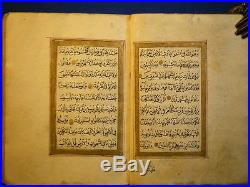
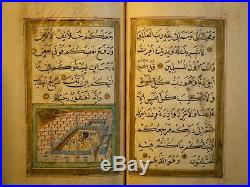
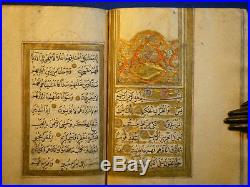
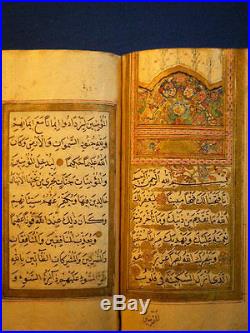
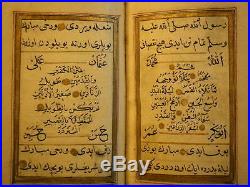
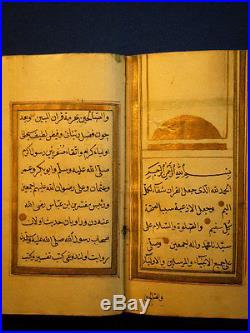
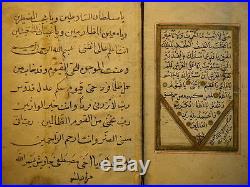
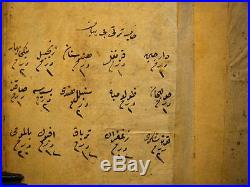
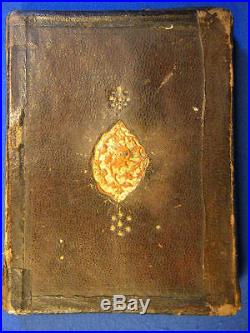
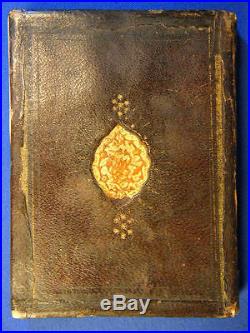
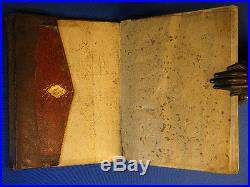

Bound in full Decorated leather, this is a presumed PERSIAN - ISLAMIC MANUSCRIPT, Illuminated and each page bordered in Gold Leaf, with additional miniatures, lettering and decoration in black and blue ink, plus orange, red, blue , green and other pigments. It measures 3.75" x 5" and contains 183 pages with text and/or illustrations, plus front and rear endpapers, which are made from a different paper fiber than the text, which is written on a very fine, ivory-surfaced laid paper. The binding is full red leather with an embossed gilt and red design centered on both covers, and with a smaller one on the flap. It appears that later thin strips of brown leather have been used to reinforce the outer edges of the boards, and the flap has been reattached with another piece of leather, and the inner hinge has been reinforced with a piece of muslin. It has the feel and appearance of a 19th century manuscript, but we defer to you, the experts. Further inquiries are welcome, and more photos can be sent upon request. All illuminations have been photographed, including the ornate double-page one, but some pages have more gold-leaf decoration to the text than others.
A Persian miniature is a small painting on paper, whether a book illustration or a separate work of art intended to be kept in an album of such works called a muraqqa. The techniques are broadly comparable to the Western and Byzantine traditions of miniatures.
Although there is an equally well-established Persian tradition of wall-painting, the survival rate and state of preservation of miniatures is better, and miniatures are much the best-known form of Persian painting in the West, and many of the most important examples are in Western, or Turkish, museums. Miniature painting became a significant genre.
In the 13th century, receiving Chinese influence after the Mongol conquests. And the highest point in the tradition was reached in the 15th and 16th centuries.
The tradition continued, under some Western influence, after this, and has many modern exponents. The Persian miniature was the dominant influence on other Islamic miniature traditions, principally the Ottoman miniature.In Turkey, and the Mughal miniature. Persian art under Islam had never completely forbidden the human figure, and in the miniature tradition the depiction of figures, often in large numbers, is central. This was partly because the miniature is a private form, kept in a book or album and only shown to those the owner chooses. It was therefore possible to be more free than in wall paintings or other works seen by a wider audience.
And other purely religious works are not known to have been illustrated in this way, though histories and other works of literature may include religiously related scenes, including those depicting the Prophet Muhammed. After 1500 usually without showing his face. As well as the figurative scenes in miniatures, which this article concentrates on, there was a parallel style of non-figurative ornamental decoration which was found in borders and panels in miniature pages, and spaces at the start or end of a work or section, and often in whole pages acting as frontispieces. In Islamic art this is referred to as "illumination", and manuscripts of the Qu'ran and other religious books often included considerable number of illuminated pages. The designs reflected contemporary work in other media, in later periods being especially close to book-covers and Persian carpets.And it is thought that many carpet designs were created by court artists and sent to the workshops in the provinces. In later periods miniatures were increasingly created as single works to be included in albums called muraqqa. This allowed non-royal collectors to afford a representative sample of works from different styles and periods.
The bright and pure colouring of the Persian miniature is one of its most striking features. Used are mineral-based ones which keep their bright colours very well if kept in proper conditions, the main exception being silver, mostly used to depict water, which will oxidize to a rough-edged black over time. The conventions of Persian miniatures changed slowly; faces are normally youthful and seen in three-quarters view, with a plump rounded lower face better suited to portraying typical Central Asian or Chinese features than those of most Persians. Lighting is even, without shadows or chiaroscuro.
Walls and other surfaces are shown either frontally, or as at (to modern eyes) an angle of about 45 degrees, often giving the modern viewer the unintended impression that a building is (say) hexagonal in plan. Buildings are often shown in complex views, mixing interior views through windows or "cutaways" with exterior views of other parts of a facade.
Costumes and architecture are always those of the time. Persian(Islamic) Manuscript with Miniatures.3.75 x 5, 183 pp" is in sale since Wednesday, September 07, 2016. This item is in the category "Antiques\Asian Antiques\Middle East". The seller is "beaufortbooks" and is located in Saint Helena Island, South Carolina. This item can be shipped worldwide.
- Type: Islamic Manuscript
- Age: 1800-1849
- Primary Material: Paper
- Original/Reproduction: Original
- Region of Origin: Middle East
